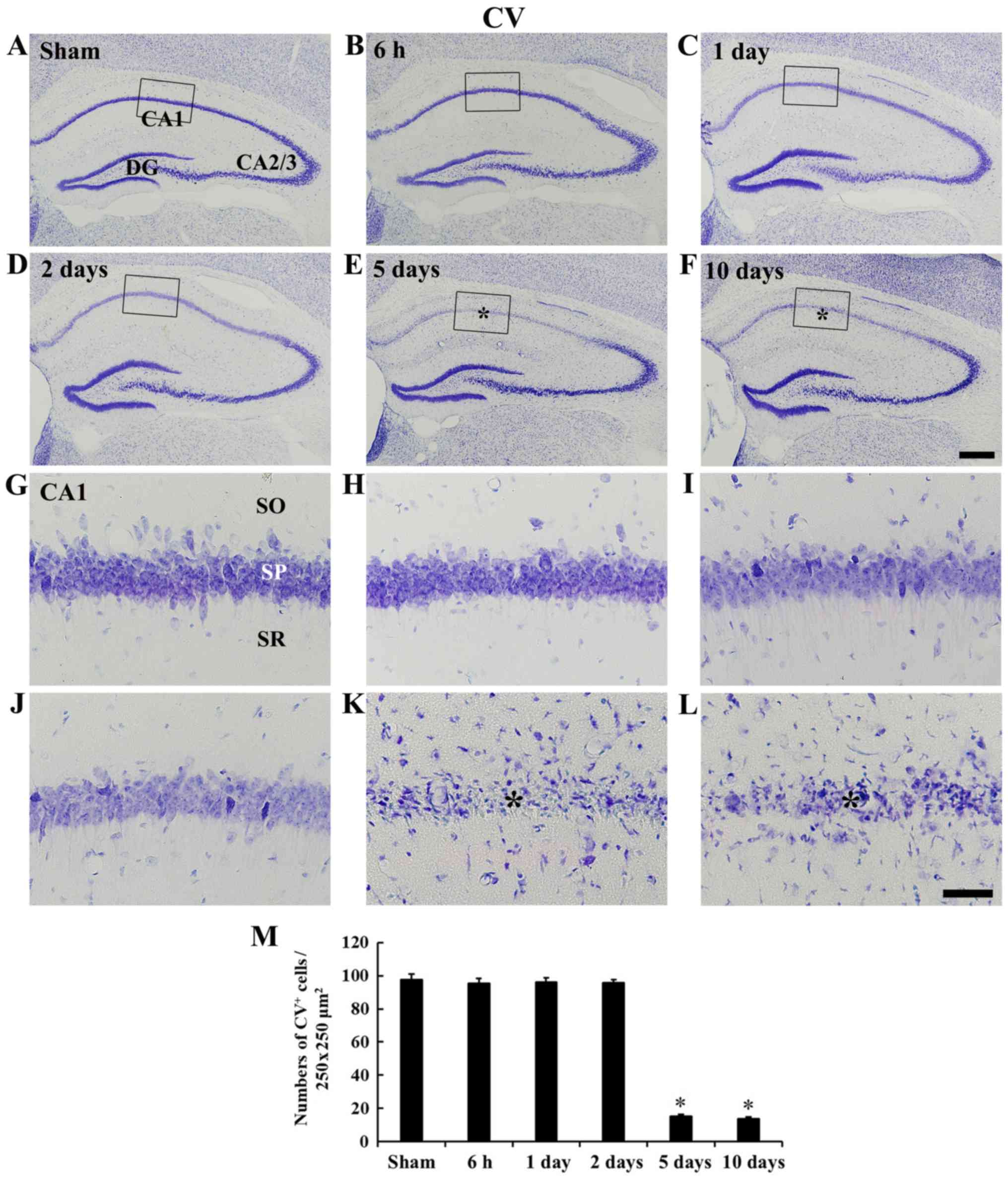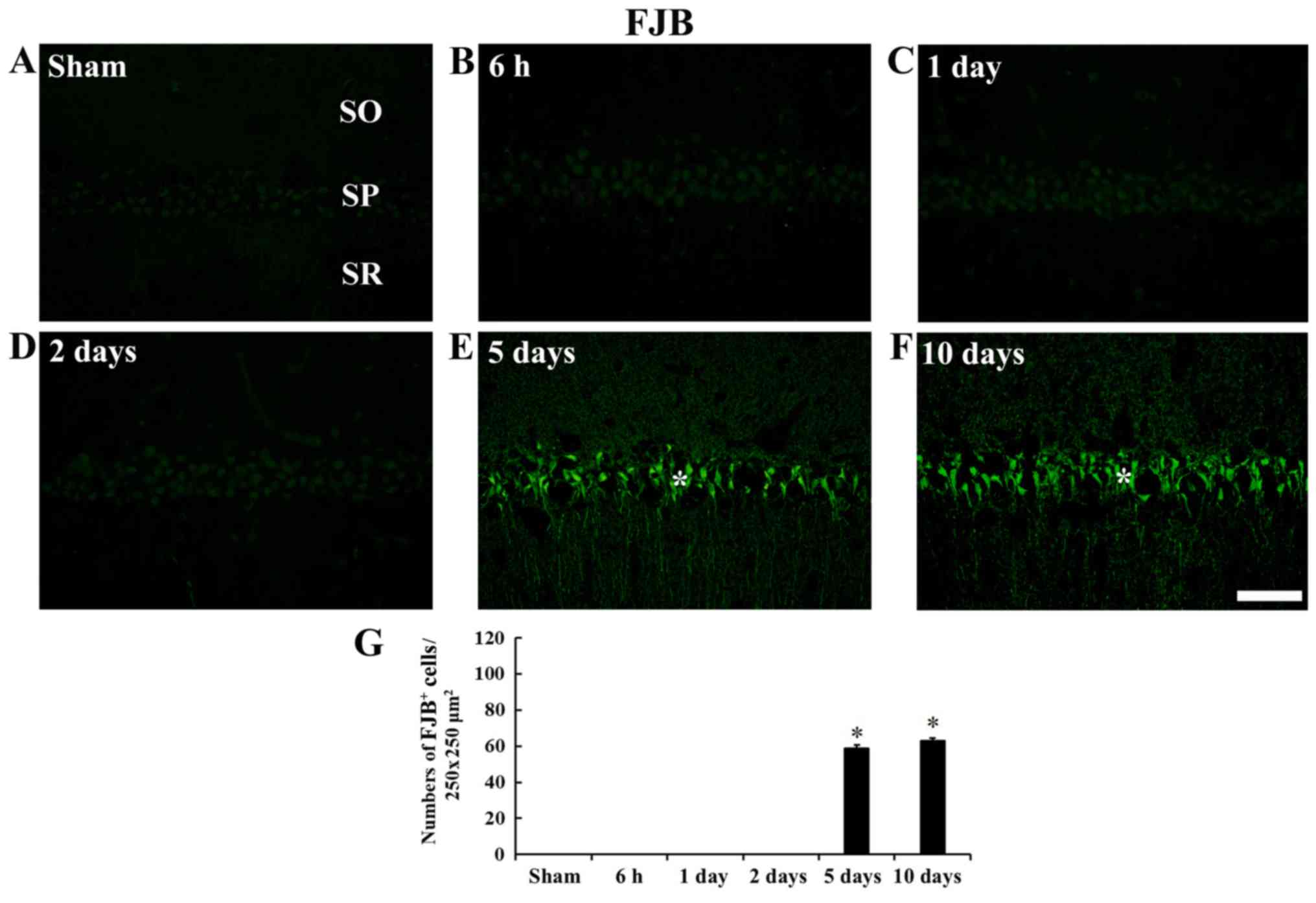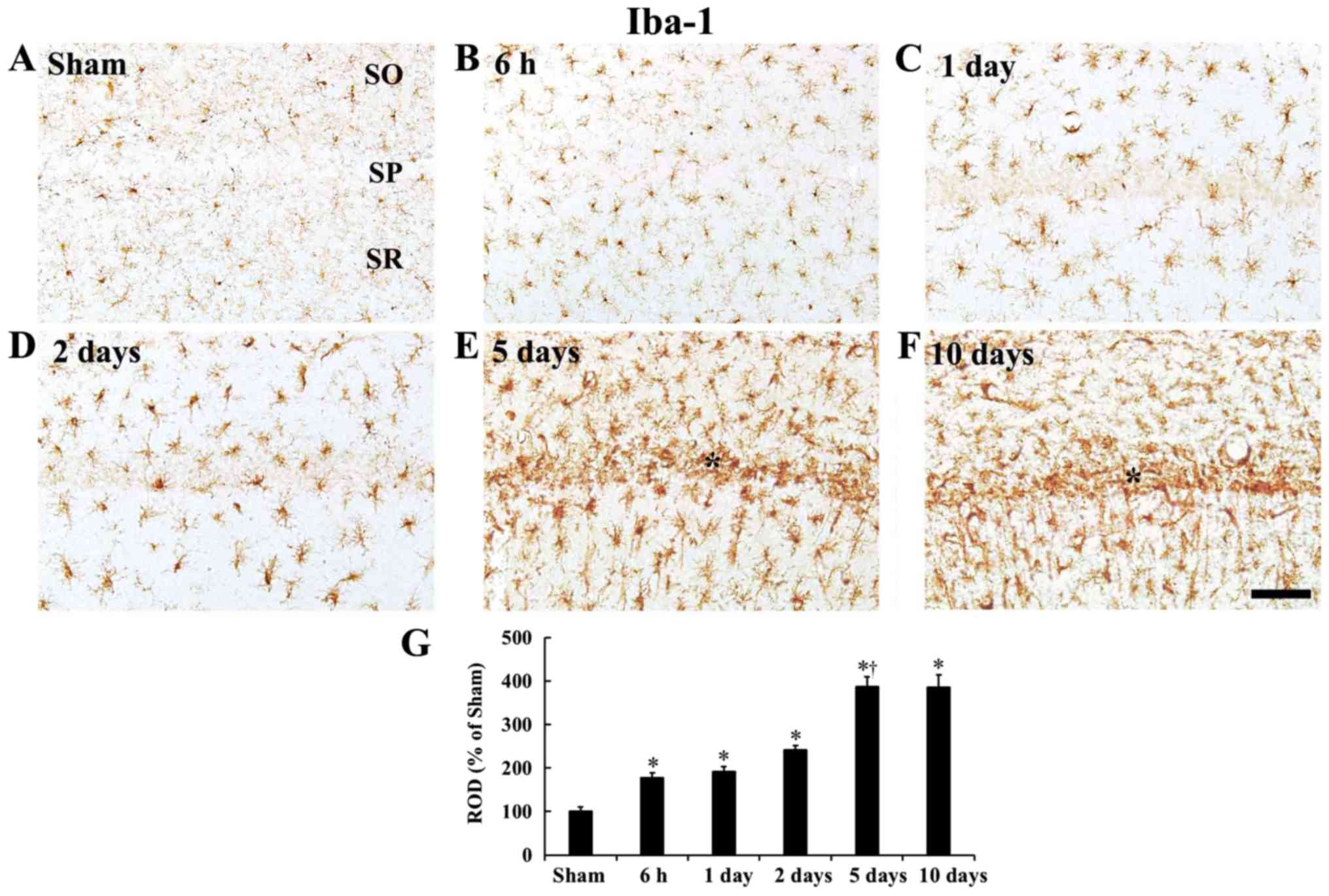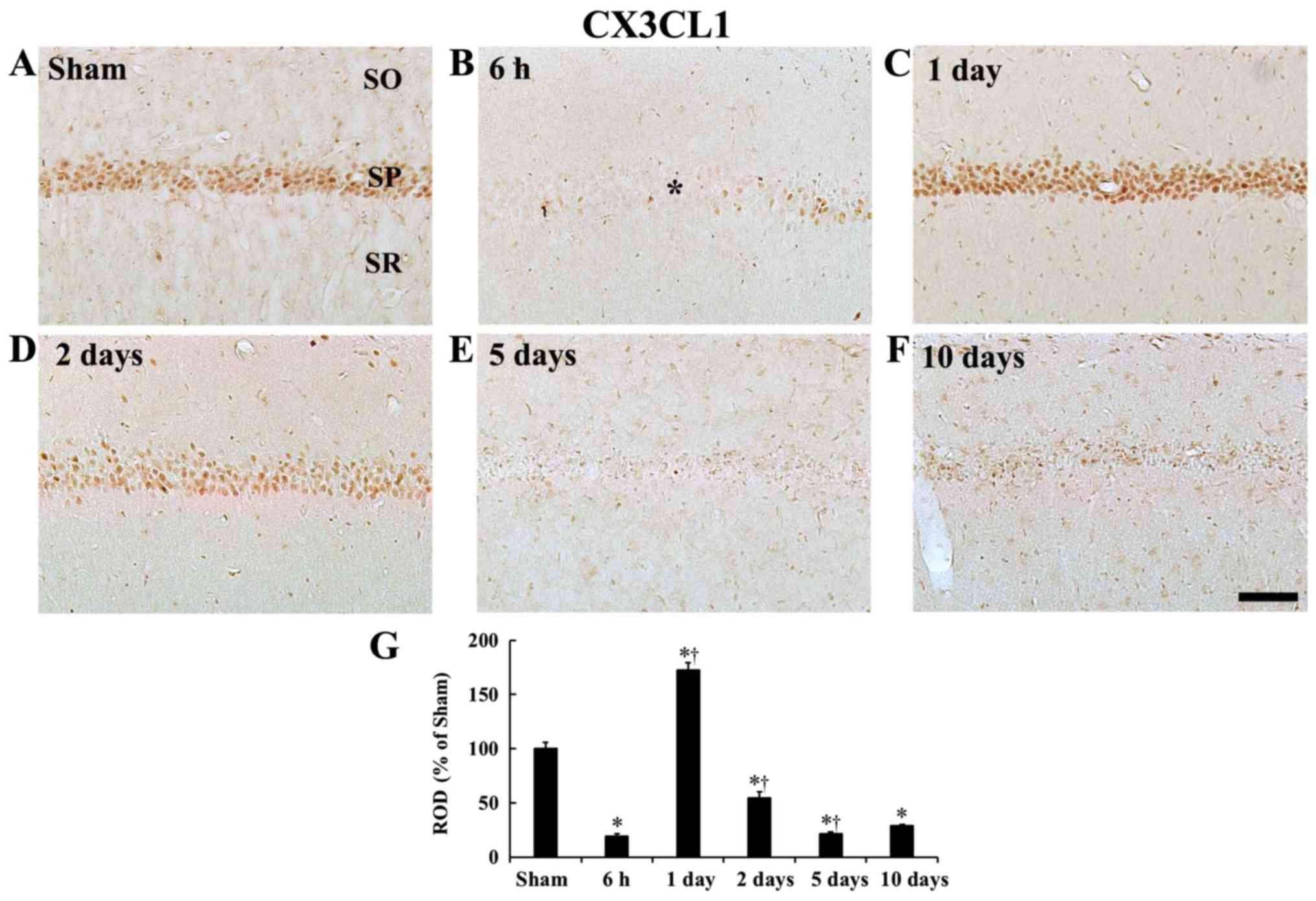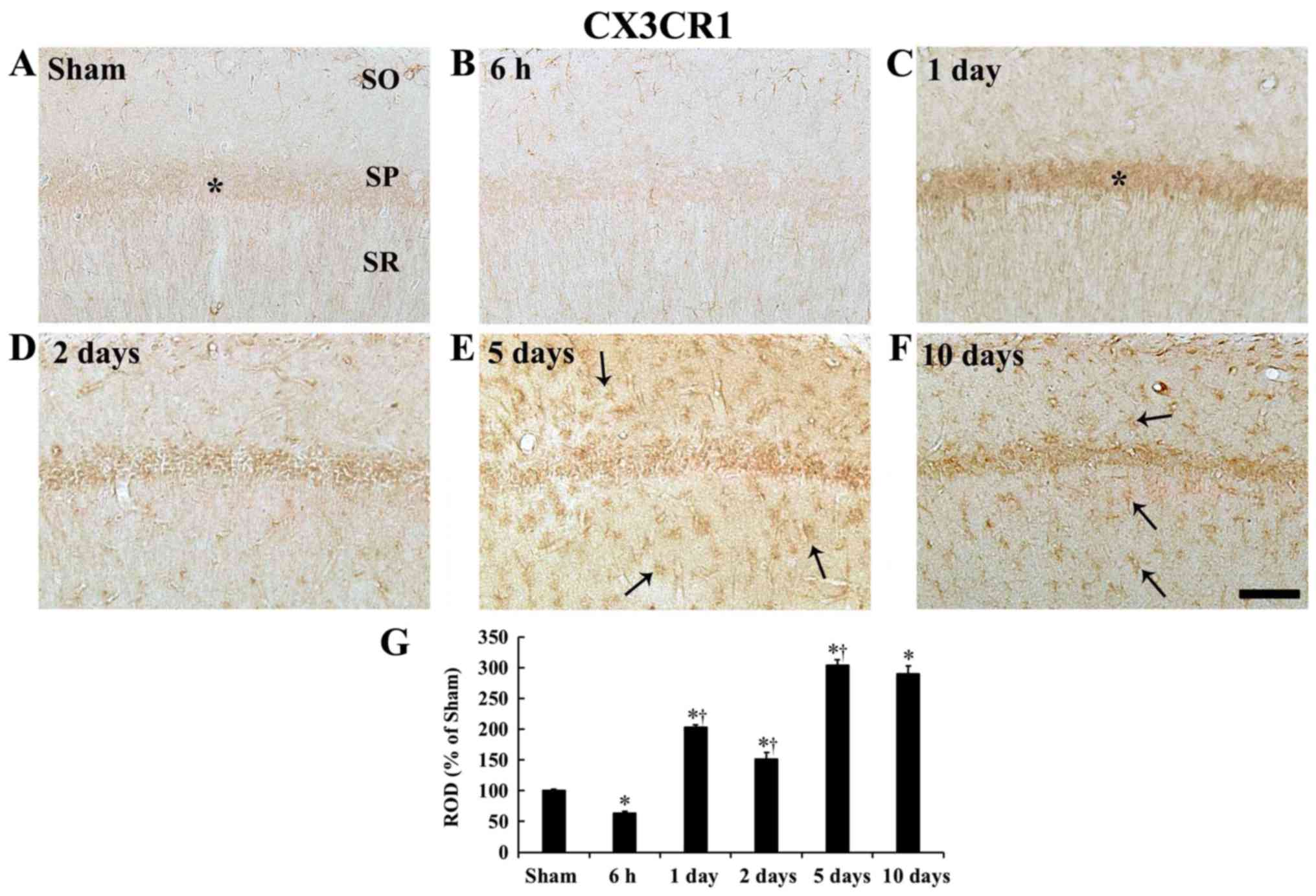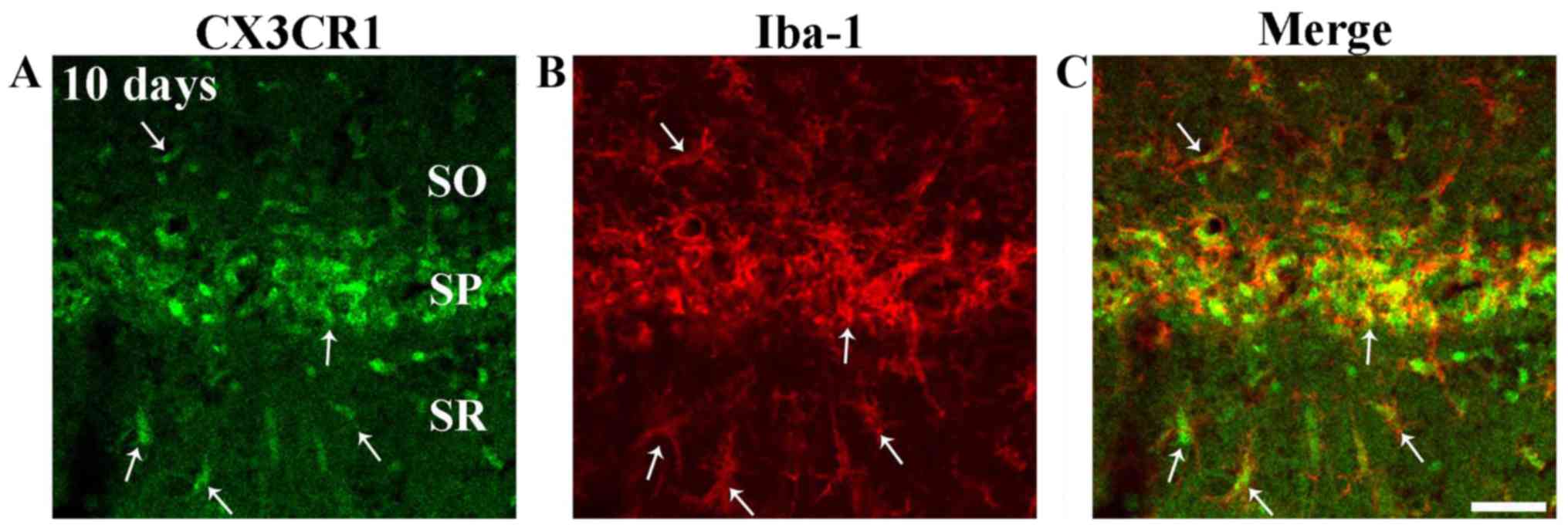|
1
|
Arundine M and Tymianski M: Molecular
mechanisms of glutamate-dependent neurodegeneration in ischemia and
traumatic brain injury. Cell Mol Life Sci. 61:657–668. 2004.
View Article : Google Scholar : PubMed/NCBI
|
|
2
|
Lee JC, Kim IH, Park JH, Ahn JH, Cho JH,
Cho GS, Tae HJ, Chen BH, Yan BC, Yoo KY, et al: Ischemic
preconditioning protects hippocampal pyramidal neurons from
transient ischemic injury via the attenuation of oxidative damage
through upregulating heme oxygenase-1. Free Radic Biol Med.
79:78–90. 2015. View Article : Google Scholar
|
|
3
|
Park JH, Kim YH, Ahn JH, Choi SY, Hong S,
Kim SK, Kang IJ, Kim YM, Lee TK, Won MH and Lee CH: Atomoxetine
protects against NMDA receptor-mediated hippocampal neuronal death
following transient global cerebral ischemia. Curr Neurovasc Res.
14:158–168. 2017. View Article : Google Scholar : PubMed/NCBI
|
|
4
|
Rastogi L, Godbole MM, Ray M, Rathore P,
Rathore P, Pradhan S, Gupta SK and Pandey CM: Reduction in
oxidative stress and cell death explains hypothyroidism induced
neuroprotection subsequent to ischemia/reperfusion insult. Exp
Neurol. 200:290–300. 2006. View Article : Google Scholar : PubMed/NCBI
|
|
5
|
Barone FC and Feuerstein GZ: Inflammatory
mediators and stroke: New opportunities for novel therapeutics. J
Cereb Blood Flow Metab. 19:819–834. 1999. View Article : Google Scholar : PubMed/NCBI
|
|
6
|
Fujiwara N, Som AT, Pham LD, Lee BJ,
Mandeville ET, Lo EH and Arai K: A free radical scavenger edaravone
suppresses systemic inflammatory responses in a rat transient focal
ischemia model. Neurosci Lett. 633:7–13. 2016. View Article : Google Scholar : PubMed/NCBI
|
|
7
|
Lee CH, Yoo KY, Choi JH, Park OK, Hwang
IK, Kim SK, Kang IJ, Kim YM and Won MH: Neuronal damage is much
delayed and microgliosis is more severe in the aged hippocampus
induced by transient cerebral ischemia compared to the adult
hippocampus. J Neurol Sci. 294:1–6. 2010. View Article : Google Scholar : PubMed/NCBI
|
|
8
|
Saito K, Suyama K, Nishida K, Sei Y and
Basile AS: Early increases in TNF-alpha, IL-6 and IL-1 beta levels
following transient cerebral ischemia in gerbil brain. Neurosci
Lett. 206:149–152. 1996. View Article : Google Scholar : PubMed/NCBI
|
|
9
|
Chen Y, Hallenbeck JM, Ruetzler C, Bol D,
Thomas K, Berman NE and Vogel SN: Overexpression of monocyte
chemoattractant protein 1 in the brain exacerbates ischemic brain
injury and is associated with recruitment of inflammatory cells. J
Cereb Blood Flow Metab. 23:748–755. 2003. View Article : Google Scholar : PubMed/NCBI
|
|
10
|
Garau A, Bertini R, Colotta F, Casilli F,
Bigini P, Cagnotto A, Mennini T, Ghezzi P and Villa P:
Neuroprotection with the CXCL8 inhibitor repertaxin in transient
brain ischemia. Cytokine. 30:125–131. 2005. View Article : Google Scholar : PubMed/NCBI
|
|
11
|
Schilling M, Strecker JK, Ringelstein EB,
Schäbitz WR and Kiefer R: The role of CC chemokine receptor 2 on
microglia activation and blood-borne cell recruitment after
transient focal cerebral ischemia in mice. Brain Res. 1289:79–84.
2009. View Article : Google Scholar : PubMed/NCBI
|
|
12
|
Nishiyori A, Minami M, Ohtani Y, Takami S,
Yamamoto J, Kawaguchi N, Kume T, Akaike A and Satoh M: Localization
of fractalkine and CX3CR1 mRNAs in rat brain: Does fractalkine play
a role in signaling from neuron to microglia? FEBS Lett.
429:167–172. 1998. View Article : Google Scholar : PubMed/NCBI
|
|
13
|
Al Mamun A, Yu H, Romana S and Liu F:
Inflammatory responses are sex specific in chronic hypoxic-ischemic
encephalopathy. Cell Transplant. 27:1328–1339. 2018. View Article : Google Scholar
|
|
14
|
Jiang T, Zhang L, Pan X, Zheng H, Chen X,
Li L, Luo J and Hu X: Physical exercise improves cognitive function
together with microglia phenotype modulation and remyelination in
chronic cerebral hypoperfusion. Front Cell Neurosci. 11:4042017.
View Article : Google Scholar
|
|
15
|
Harrison JK, Jiang Y, Chen S, Xia Y,
Maciejewski D, McNamara RK, Streit WJ, Salafranca MN, Adhikari S,
Thompson DA, et al: Role for neuronally derived fractalkine in
mediating interactions between neurons and CX3CR1-expressing
microglia. Proc Natl Acad Sci USA. 95:10896–10901. 1998. View Article : Google Scholar : PubMed/NCBI
|
|
16
|
Chapman GA, Moores K, Harrison D, Campbell
CA, Stewart BR and Strijbos PJ: Fractalkine cleavage from neuronal
membranes represents an acute event in the inflammatory response to
excitotoxic brain damage. J Neurosci. 20:RC872000. View Article : Google Scholar : PubMed/NCBI
|
|
17
|
Tarozzo G, Campanella M, Ghiani M, Bulfone
A and Beltramo M: Expression of fractalkine and its receptor,
CX3CR1, in response to ischaemia-reperfusion brain injury in the
rat. Eur J Neurosci. 15:1663–1668. 2002. View Article : Google Scholar : PubMed/NCBI
|
|
18
|
Dénes A, Ferenczi S, Halász J, Környei Z
and Kovács KJ: Role of CX3CR1 (fractalkine receptor) in brain
damage and inflammation induced by focal cerebral ischemia in
mouse. J Cereb Blood Flow Metab. 28:1707–1721. 2008. View Article : Google Scholar : PubMed/NCBI
|
|
19
|
Pabon MM, Bachstetter AD, Hudson CE, Gemma
C and Bickford PC: CX3CL1 reduces neurotoxicity and microglial
activation in a rat model of Parkinson's disease. J
Neuroinflammation. 8:92011. View Article : Google Scholar : PubMed/NCBI
|
|
20
|
Ransohoff RM, Liu L and Cardona AE:
Chemokines and chemokine receptors: Multipurpose players in
neuroinflammation. Int Rev Neurobiol. 82:187–204. 2007. View Article : Google Scholar : PubMed/NCBI
|
|
21
|
Liu Y, Wu XM, Luo QQ, Huang S, Yang QW,
Wang FX, Ke Y and Qian ZM: CX3CL1/CX3CR1-mediated microglia
activation plays a detrimental role in ischemic mice brain via
p38MAPK/PKC pathway. J Cereb Blood Flow Metab. 35:1623–1631. 2015.
View Article : Google Scholar : PubMed/NCBI
|
|
22
|
Wang J, Gan Y, Han P, Yin J, Liu Q,
Ghanian S, Gao F, Gong G and Tang Z: Ischemia-induced neuronal cell
death is mediated by chemokine receptor CX3CR1. Sci Rep. 8:5562018.
View Article : Google Scholar : PubMed/NCBI
|
|
23
|
Zhu J, Zhou Z, Liu Y and Zheng J:
Fractalkine and CX3CR1 are involved in the migration of
intravenously grafted human bone marrow stromal cells toward
ischemic brain lesion in rats. Brain Res. 1287:173–183. 2009.
View Article : Google Scholar : PubMed/NCBI
|
|
24
|
Kirino T: Delayed neuronal death in the
gerbil hippocampus following ischemia. Brain Res. 239:57–69. 1982.
View Article : Google Scholar : PubMed/NCBI
|
|
25
|
Onken M, Berger S and Kristian T: Simple
model of forebrain ischemia in mouse. J Neurosci Methods.
204:254–261. 2012. View Article : Google Scholar :
|
|
26
|
Park JH, Park O, Cho JH, Chen BH, Kim IH,
Ahn JH, Lee JC, Yan BC, Yoo KY, Lee CH, et al: Anti-inflammatory
effect of tanshinone I in neuroprotection against cerebral
ischemia-reperfusion injury in the gerbil hippocampus. Neurochem
Res. 39:1300–1312. 2014. View Article : Google Scholar : PubMed/NCBI
|
|
27
|
Park JH, Shin BN, Ahn JH, Cho JH, Kim IH,
Kim DW, Won MH, Hong S, Cho JH and Lee CH: Ischemia-induced changes
of PRAS40 and p-PRAS40 immunoreactivities in the gerbil hippocampal
CA1 region after transient cerebral ischemia. Cell Mol Neurobiol.
36:821–828. 2016. View Article : Google Scholar
|
|
28
|
Kaufman GD, Shinder ME and Perachio AA:
Correlation of fos expression and circling asymmetry during gerbil
vestibular compensation. Brain Res. 817:246–255. 1999. View Article : Google Scholar : PubMed/NCBI
|
|
29
|
Du X, Wang D, Li Y, Huo X, Li C, Lu J,
Wang Y, Guo M and Chen Z: Newly breeding an inbred strain of
ischemia-prone mongolian gerbils and its reproduction and genetic
characteristics. Exp Anim. 67:83–90. 2018. View Article : Google Scholar :
|
|
30
|
Zhu XL, Yan BC, Tang C, Qiu GW, Wu Y, Wang
J and Bo P: Neuroprotective effect of paeoniae radix rubra on
hippocampal CA1 region of mice induced by transient focal cerebral
ischemia via anti-gliosis and anti-oxidant activity. Chin Herb
Medicines. 11:86–91. 2019. View Article : Google Scholar
|
|
31
|
Ahn JH, Shin BN, Park JH, Kim IH, Cho JH,
Chen B, Lee TK, Tae HJ, Lee JC, Cho JH, et al: Long-term
observation of neuronal degeneration and microgliosis in the gerbil
dentate gyrus after transient cerebral ischemia. J Neurol Sci.
363:21–26. 2016. View Article : Google Scholar : PubMed/NCBI
|
|
32
|
Schmued LC and Hopkins KJ: Fluoro-Jade B:
A high affinity fluorescent marker for the localization of neuronal
degeneration. Brain Res. 874:123–130. 2000. View Article : Google Scholar : PubMed/NCBI
|
|
33
|
Meucci O, Fatatis A, Simen AA and Miller
RJ: Expression of CX3CR1 chemokine receptors on neurons and their
role in neuronal survival. Proc Natl Acad Sci USA. 97:8075–8080.
2000. View Article : Google Scholar : PubMed/NCBI
|
|
34
|
Cipriani R, Villa P, Chece G, Lauro C,
Paladini A, Micotti E, Perego C, De Simoni MG, Fredholm BB, Eusebi
F and Limatola C: CX3CL1 is neuroprotective in permanent focal
cerebral ischemia in rodents. J Neurosci. 31:16327–16335. 2011.
View Article : Google Scholar : PubMed/NCBI
|
|
35
|
Qin W, Li Z, Luo S, Wu R, Pei Z and Huang
R: Exogenous fractalkine enhances proliferation of endothelial
cells, promotes migration of endothelial progenitor cells and
improves neurological deficits in a rat model of ischemic stroke.
Neurosci Lett. 569:80–84. 2014. View Article : Google Scholar : PubMed/NCBI
|
|
36
|
Soriano SG, Amaravadi LS, Wang YF, Zhou H,
Yu GX, Tonra JR, Fairchild-Huntress V, Fang Q, Dunmore JH, Huszar D
and Pan Y: Mice deficient in fractalkine are less susceptible to
cerebral ischemia-reperfusion injury. J Neuroimmunol. 125:59–65.
2002. View Article : Google Scholar : PubMed/NCBI
|
|
37
|
Tang Z, Gan Y, Liu Q, Yin JX, Liu Q, Shi J
and Shi FD: CX3CR1 deficiency suppresses activation and
neurotoxicity of microglia/macrophage in experimental ischemic
stroke. J Neuroinflammation. 11:262014. View Article : Google Scholar : PubMed/NCBI
|
|
38
|
van der Maten G, Henck V, Wieloch T and
Ruscher K: CX3C chemokine receptor 1 deficiency modulates microglia
morphology but does not affect lesion size and short-term deficits
after experimental stroke. BMC Neurosci. 18:112017. View Article : Google Scholar :
|
|
39
|
Fumagalli S, Perego C, Ortolano F and De
Simoni MG: CX3CR1 deficiency induces an early protective
inflammatory environment in ischemic mice. Glia. 61:827–842. 2013.
View Article : Google Scholar : PubMed/NCBI
|
|
40
|
Yeo SI, Kim JE, Ryu HJ, Seo CH, Lee BC,
Choi IG, Kim DS and Kang TC: The roles of fractalkine/CX3CR1 system
in neuronal death following pilocarpine-induced status epilepticus.
J Neuroimmunol. 234:93–102. 2011. View Article : Google Scholar : PubMed/NCBI
|
|
41
|
Nitatori T, Sato N, Waguri S, Karasawa Y,
Araki H, Shibanai K, Kominami E and Uchiyama Y: Delayed neuronal
death in the CA1 pyramidal cell layer of the gerbil hippocampus
following transient ischemia is apoptosis. J Neurosci.
15:1001–1011. 1995. View Article : Google Scholar : PubMed/NCBI
|
|
42
|
Yan BC, Ohk TG, Ahn JH, Park JH, Chen BH,
Lee JC, Lee CH, Shin MC, Hwang IK, Moon SM, et al: Differences in
neuronal damage and gliosis in the hippocampus between young and
adult gerbils induced by long duration of transient cerebral
ischemia. J Neurol Sci. 337:129–136. 2014. View Article : Google Scholar
|
|
43
|
Sugawara T, Lewén A, Noshita N, Gasche Y
and Chan PH: Effects of global ischemia duration on neuronal,
astroglial, oligodendroglial, and microglial reactions in the
vulnerable hippocampal CA1 subregion in rats. J Neurotrauma.
19:85–98. 2002. View Article : Google Scholar : PubMed/NCBI
|
















